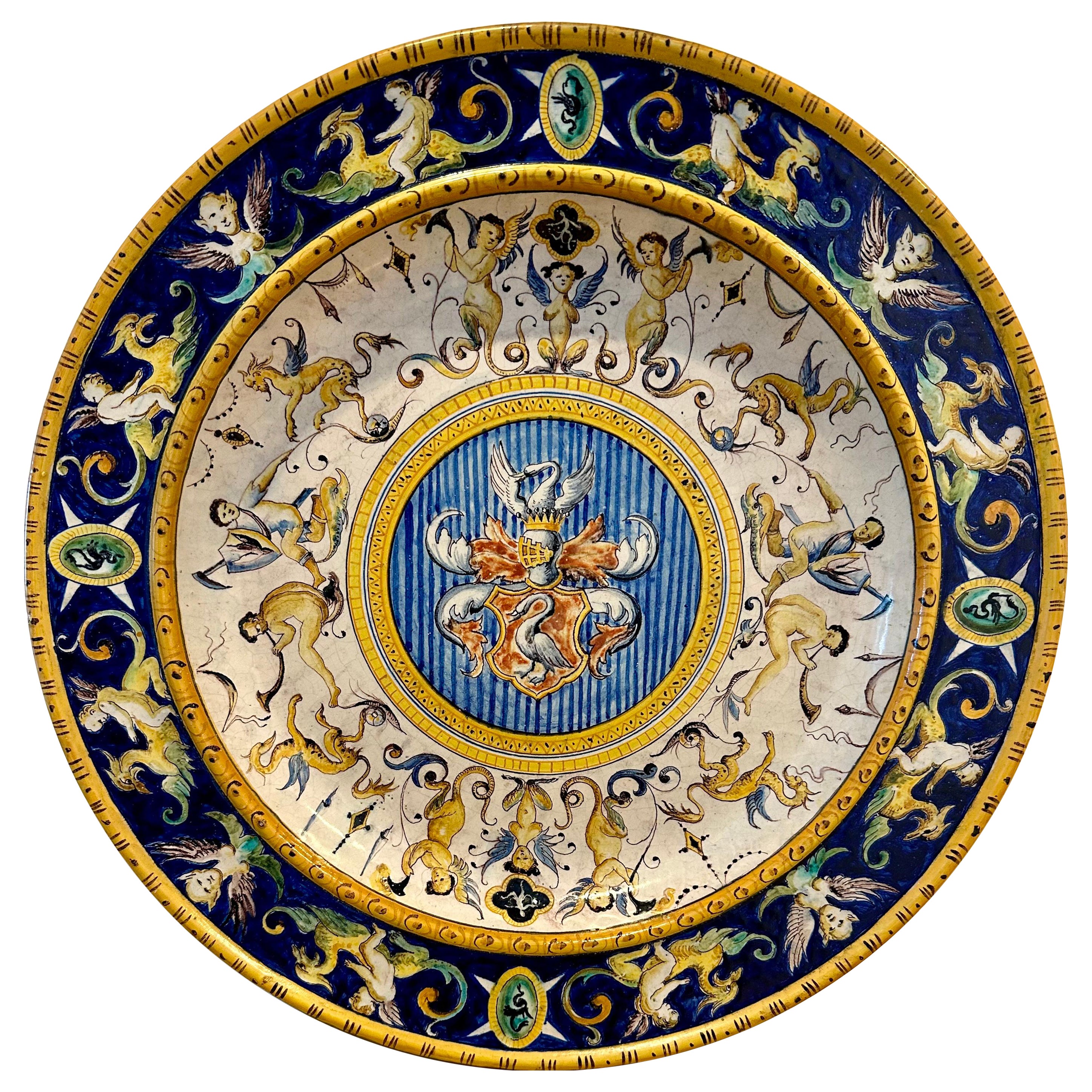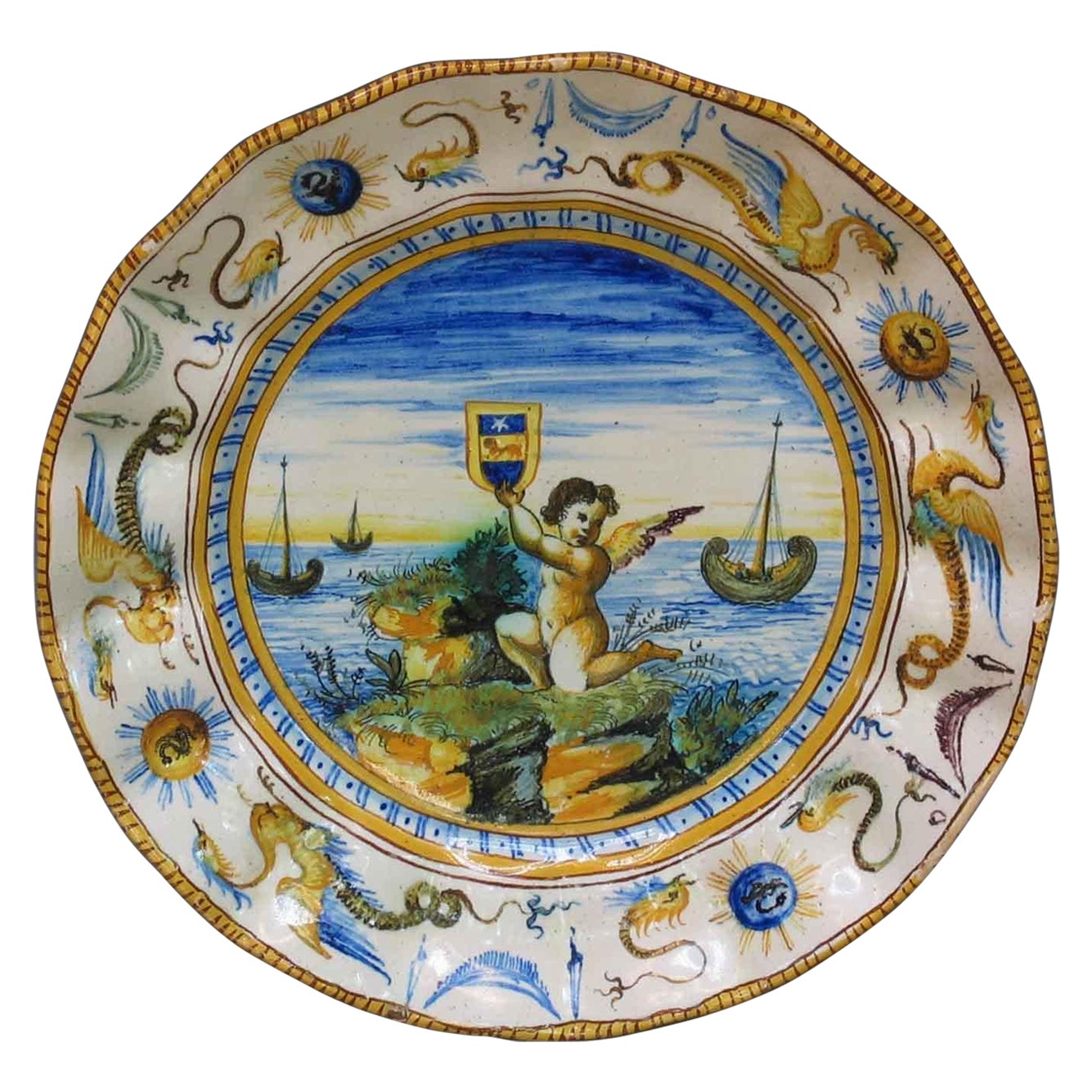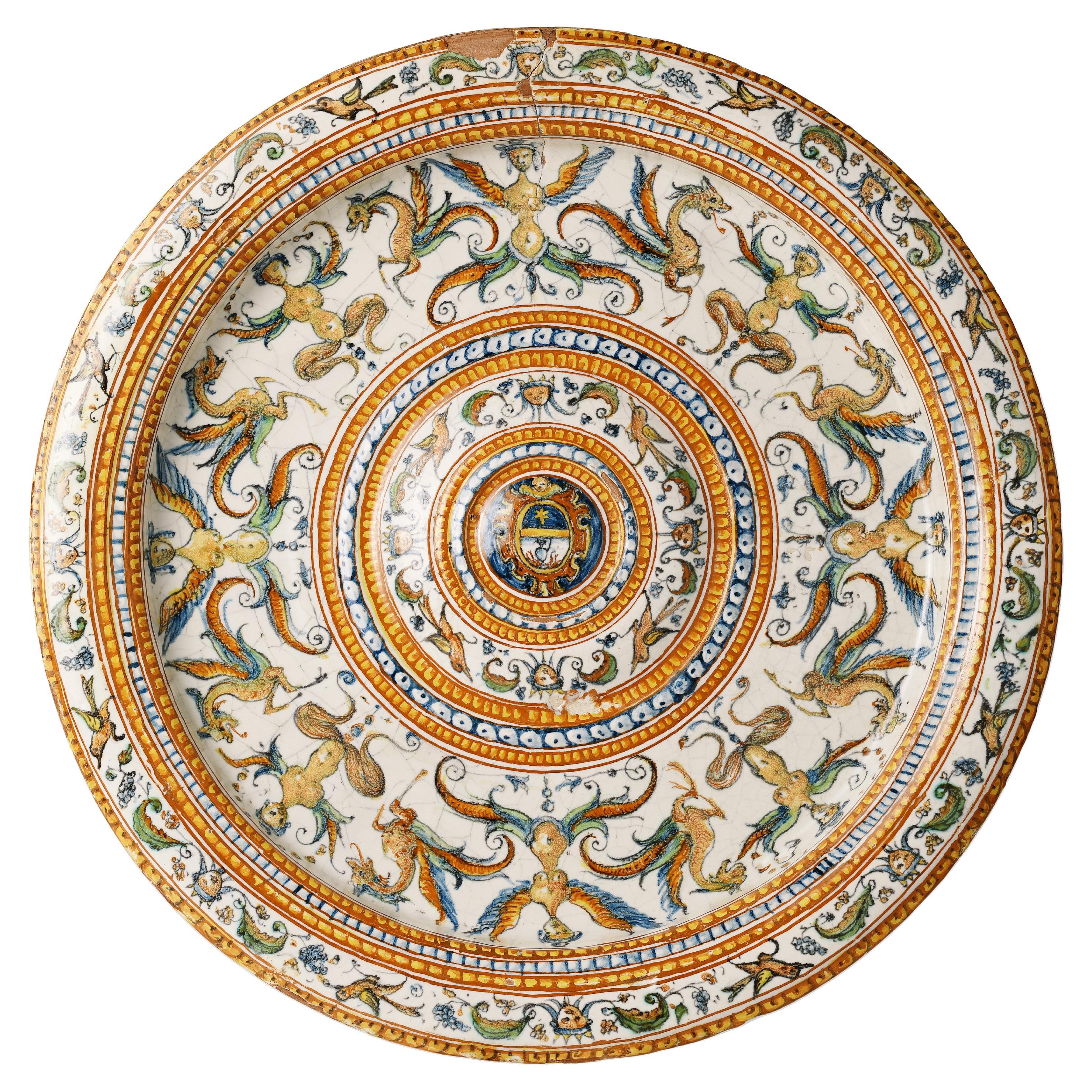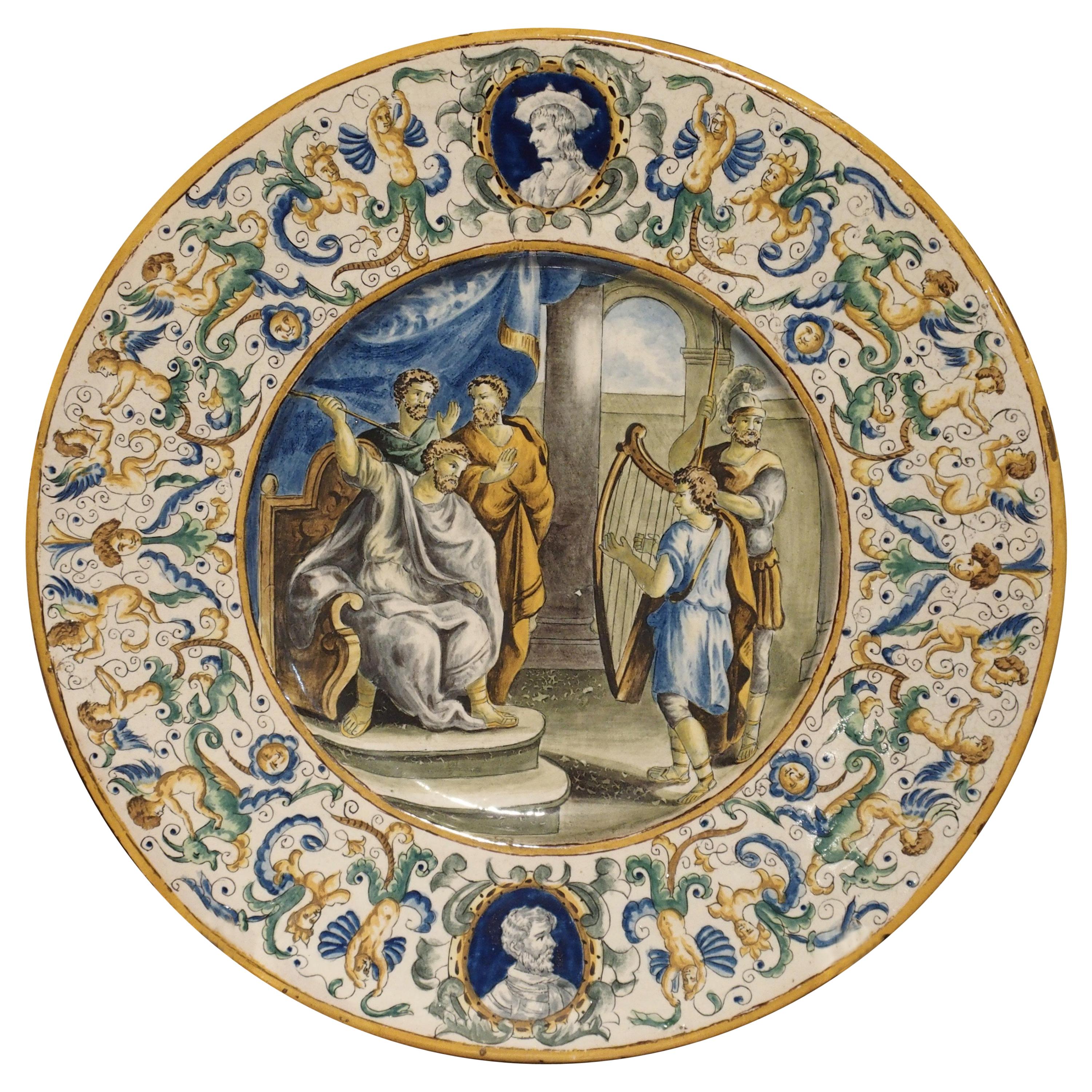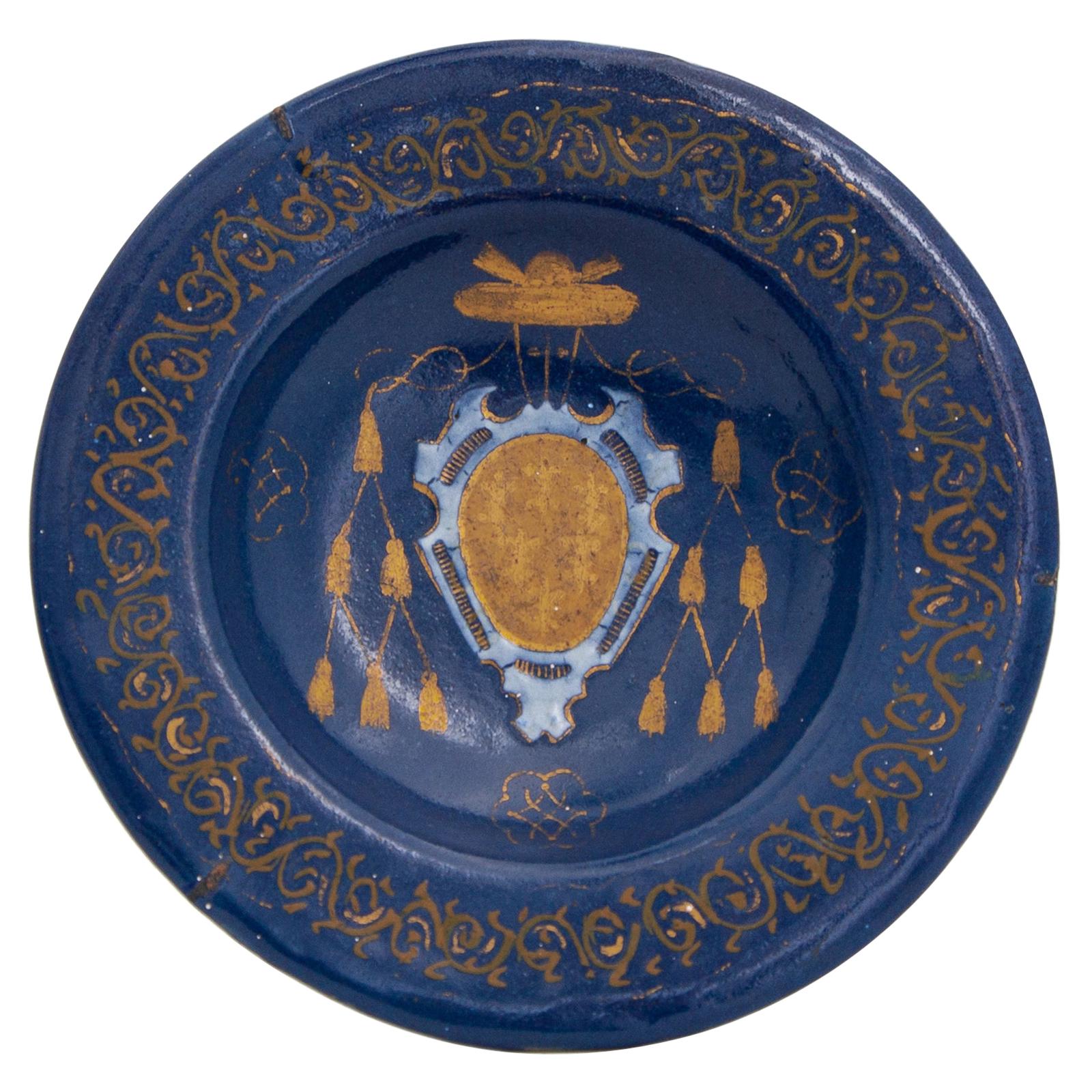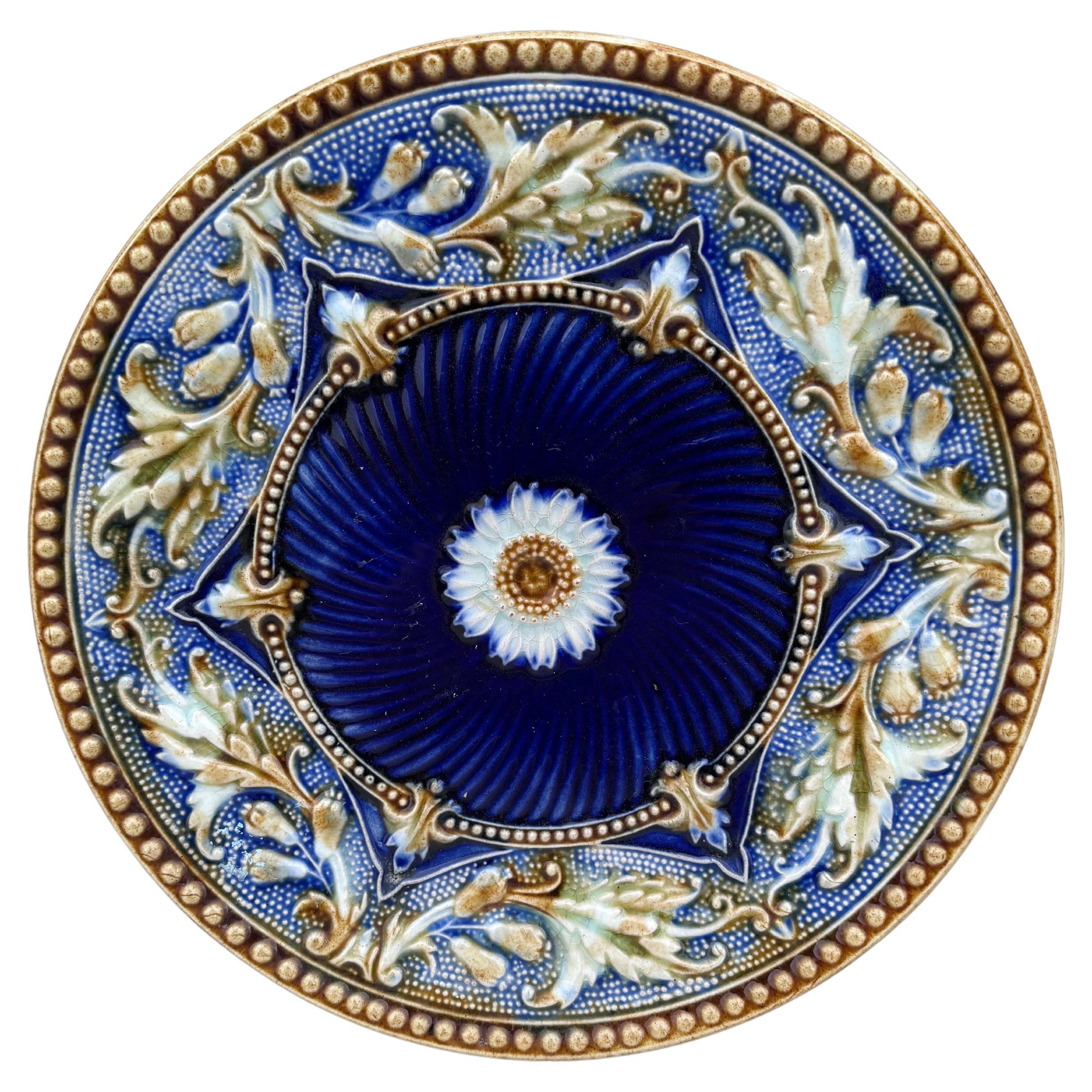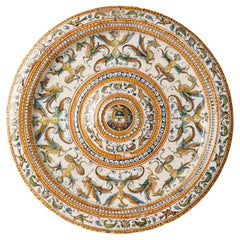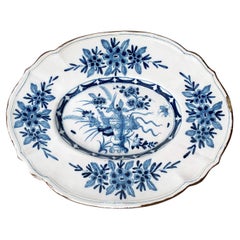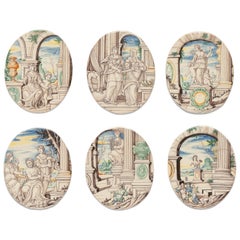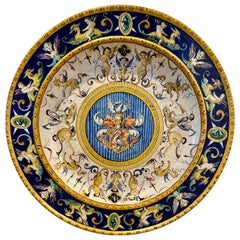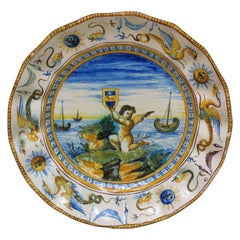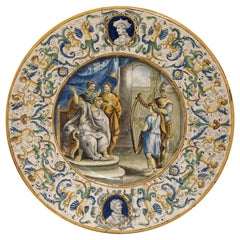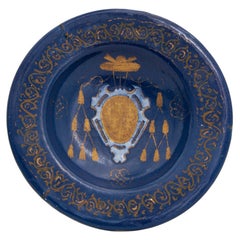Items Similar to Small Maiolica Plate, Urbino District, 1533-1555
Video Loading
Want more images or videos?
Request additional images or videos from the seller
1 of 18
Small Maiolica Plate, Urbino District, 1533-1555
$23,629.05
£17,711.44
€20,000
CA$32,462.30
A$36,241.11
CHF 18,989.79
MX$443,626.70
NOK 241,170.58
SEK 227,393.23
DKK 152,247.30
Shipping
Retrieving quote...The 1stDibs Promise:
Authenticity Guarantee,
Money-Back Guarantee,
24-Hour Cancellation
About the Item
Maiolica plate (tondino)
Urbino district, Casteldurante or Pesaro, 1533-1555
It measures: diam. 7.48 in (19 cm), foot diam. 2.75 in (7 cm), height 1.02 in (2,6 cm)
It weighs: 0.67 lb (307 g)
State of conservation: chipping on edge from use and a slight fêlure.
The small plate or “tondino” has a deep well, an oblique border, rounded edge and barely raised ring foot.
The decoration shows, around the edge, a garland of small lanceolate leaves outlined in brown, while the border is richly decorated with the “bianco sopra bianco” (white-on-white) technique. This provides a dense decoration with foliated spirals, outlined in tin white directly on the glaze. Inside the well, in a hilly landscape with the sunset sky, there is a shield framed with the bipartite noble emblem of the Mazza family of Pesaro, surmounted by the letter "M" and flanked by the initials "G" and "P".
The technique used here in the decoration of the border is widely described by Cipriano Piccolpasso in his text, from around 1557, “Li tre libri dell’arte del vasaio” and referring specifically to an Urbino tradition: in the chapter of the “Sopra bianchi “(“White Above”) the author says “questo è uso urbinate” ("this is Urbino custom").
Works with this ornament datable to between 1530 and 1555 were actually found in the Urbino district: numerous fragments from the Ducal Palace of Urbania (Castel Durante), while recent finds in Pesaro, along with those in the Ducal Palace of Urbino itself, explain the difficulty in attributing the work more precisely to one workshop in particular.
Piccolpasso himself underlines slight differences between the works of Casteldurante and those of Urbino. More recent studies tend to propose a Pesaro origin for this service, however, as it was produced for an important family of the coastal city. There is a record of the transfer, around 1534, to Pesaro of Giovanni and his brother Bartolommeo, sons of Antonio Mazza, a spice merchant from Rimini. Then we remember a Gasparre Mazza representative of a second generation of the family. It is therefore likely that the service was produced for the house of Giovanni or Gasparre ("G") Mazza ("M") for the marriage to a hypothetical "P", whose identity, for the moment, remains unknown.
Other small plates of the service, of different sizes, are preserved in public and private collections: see for example the sample, without initials, in the Victoria and Albert Museum (C 2262-1910) and the one, still without initials, at the MET in New York. Another one is attested in the Dreyfuss collection in 1967, while an identical plate has recently been published and is kept in a private collection in Genoa.
Some other unpublished plates from the service are known to be in a private collection, testifying to the importance of the Mazza family's “credenza”.
Bibliography:
Wilson T., The Golden Age of Italian Maiolica Painting, Torino, 2019, pp. 366-368 n. 163 e bibliografia relativa.
Piccolpasso C., I tre libri dell’arte del vasaio, a cura di Giovanni Cecchini, Roma 1963;
Gresta, Riccardo, Un piatto con lo stemma Mazza e qualche nota sui soprabianchi, Faenza: bollettino del Museo internazionale delle ceramiche in Faenza: CIII, 1, 2017 p. 46-55;
Gresta R., Bonali P., La maiolica pesarese nella seconda metà del Cinquecento, in “Pesaro nell’età dei Della Rovere, vol. III.2 di Historica Pisaurensia”, Collana di studi diretta da Scevola Mariotti, Venezia. pp. 354-355
Ravanelli Guidotti C., Thesaurus di opere della tradizione di Faenza, Faenza 1998, p. 254.
- Dimensions:Height: 1.03 in (2.6 cm)Diameter: 7.49 in (19 cm)
- Style:Renaissance (Of the Period)
- Materials and Techniques:Maiolica,Glazed
- Place of Origin:
- Period:
- Date of Manufacture:1533-1555
- Condition:Minor fading. Chipping on edge from use and a slight fêlure.
- Seller Location:Milano, IT
- Reference Number:1stDibs: LU4352228952192
About the Seller
4.3
Vetted Professional Seller
Every seller passes strict standards for authenticity and reliability
Established in 1860
1stDibs seller since 2018
21 sales on 1stDibs
Associations
International Confederation of Art and Antique Dealers' Associations
- ShippingRetrieving quote...Shipping from: Milano, Italy
- Return Policy
Authenticity Guarantee
In the unlikely event there’s an issue with an item’s authenticity, contact us within 1 year for a full refund. DetailsMoney-Back Guarantee
If your item is not as described, is damaged in transit, or does not arrive, contact us within 7 days for a full refund. Details24-Hour Cancellation
You have a 24-hour grace period in which to reconsider your purchase, with no questions asked.Vetted Professional Sellers
Our world-class sellers must adhere to strict standards for service and quality, maintaining the integrity of our listings.Price-Match Guarantee
If you find that a seller listed the same item for a lower price elsewhere, we’ll match it.Trusted Global Delivery
Our best-in-class carrier network provides specialized shipping options worldwide, including custom delivery.More From This Seller
View AllItalian Renaissance Plate, Patanazzi Workshop Urbino, End of 16th Century
By Patanazzi Workshop
Located in Milano, IT
Acquareccia plate
Patanazzi workshop
Urbino, last quarter of the 16th century
It measures diameter 17.12 in; foot diameter 11.53 in; height 1.88 in (43.5 cm; 29.3 cm; 4.8 cm).
Weight
State of conservation: wear and a few small minimal detachments of enamel, chipping on the raised areas, peeling of enamel at the brim on the back.
This large, shallow basin is equipped with a wide and convex well. It is umbonate with a contoured center. The brim, short and flat, is enclosed in a double rounded and barely raised edge. The basin has a flat base without rims; it has a slightly concave center in correspondence to the well.
The shape takes inspiration from the basins associated with the metal forged amphora pourers that traditionally adorned the credenza. These were used from the Middle Ages to wash hands during banquets. Two or three people washed their hands in the same basin and it was considered an honor to wash one’s hands with an illustrious person.
The decoration is arranged in concentric bands with, in the center of the umbo, an unidentified shield on a blue background: an oval banded in gold with a blue head, a gold star and a field with a burning pitcher.
Rings of faux pods separate the center from a series of grotesque motifs of small birds and masks. These go around the basin and are, in fact, faithfully repeated on the brim. The main decoration develops inside the flounce of the basin, which sees alternating symmetrical figures of winged harpies and chimeras. The ornamentation, outlined in orange, green and blue, stands out against the white enamel background.
This decorative style, defined since the Renaissance as “grottesche” or “raffaellesche”, refers to the decorations introduced after the discovery of the paintings of the Domus Aurea towards the end of the fifteenth century. The discovery of Nero's palace, buried inside Colle Oppio by damnatio memoriae, occurred by chance when a young Roman, in 1480, fell into a large crack which had opened in the ground on the hill, thus finding himself in a cave with walls covered with painted figures.
The great artists present in the papal city, including Pinturicchio, Ghirlandaio, Raffaello, immediately visited these caves. The decorations found there soon became a decorative subject of immense success: the term grotesque , with the meaning of “unusual,” “caricatured,” or “monstrous,” was later commented by Vasari in 1550 as “una spezie di pittura licenziose e ridicole molto”( “a very licentious and ridiculous kind of painting”).
The decorations “a grottesche” also widely circulated in ceramic factories, through the use of engravings, variously interpreted according to the creativity of the artists or the requests of the client.
Our basin is reflected in similar artifacts produced at the end of the sixteenth century by the factories of the Urbino district. See the series of basins preserved in the main French museums, among which the closest in morphology is that of the Campana collection of the Louvre (Inv. OA1496); this however has a more complex figure decoration, while the decoration of our specimen is sober and with a watercolor style.
The style, sure in its execution, approaches decorative results still close to the works produced around the middle of the sixteenth century by the Fontana workshop. The decoration is closely linked to their taste, which later finds its natural outlet, through the work of Antonio, also in the Patanazzi workshop. Studies show the contiguity between the two workshops due to the kinship and collaboration between the masters Orazio Fontana and Antonio Patanazzi, both trained in the workshop of Guido Fontana il Durantino. It is therefore almost natural that their works, often created according to similar typologies and under the aegis of the same commissions, are not always easily distinguishable, so much so that the presence of historiated or “grottesche” works by Orazio is documented and preserved in Antonio Patanazzi's workshop. Given that the studies have always emphasized the collaboration between several hands in the context of the shops, it is known that the most ancient “grottesche” works thus far known, can be dated from 1560, when the Fontana shop created the so-called Servizio Spagnolo (Spanish Service) and how, from that moment on, this ornamentation became one of the most requested by high-ranking clients. We remember the works created for the Granduchi di Toscana, when Flaminio Fontana along with his uncle Orazio supplied ceramics to Florence, and, later, other commissions of considerable importance: those for the service of the Duchi d’Este or for the Messina Farmacia of Roccavaldina, associated with the Patanazzi workshop when, now after 1580, Antonio Patanazzi began to sign his own work.
Thus, in our basin, the presence of masks hanging from garlands, a theme of more ancient memory, is associated in the work with more advanced stylistic motifs, such as the hatching of the chimeras and harpies. These are found here on the front with the wings painted in two ornate ways. In addition, the theme of the birds on the edge completes the decoration along the thin brim and can be seen as representing an early style typical of the Urbino district during a period of activity and collaboration between the two workshops. Later, a more “doll-like” decorative choice, typical of the end of the century and the beginning of the seventeenth century, characterized the period of the Patanazzi workshop under the direction of Francesco.
Bibliography:
Philippe Morel, Il funzionamento simbolico e la critica delle grottesche nella seconda metà del Cinquecento, in: Marcello Fagiolo, (a cura di), Roma e...
Category
Antique 16th Century Italian Renaissance Ceramics
Materials
Maiolica
Maiolica Oval Tray, Felice Clerici Manufactory, Milan, Circa 1770-1780
By Felice Clerici
Located in Milano, IT
Small oval tray
Felice Clerici Manufactory 1745-1780
Milan, Circa 1770-1780
Maiolica polychrome.
Dimensions: 10.82 x 8.66 in (27.5 x 22 cm); weight 0.4...
Category
Antique 1770s Italian Rococo Ceramics
Materials
Maiolica
18th Century Italian Maiolica Centerpiece Bassano Venice, circa 1750
Located in Milano, IT
Maiolica centerpiece
Pasquale Antonibon factory
Nove di Bassano, Venice, 1740-1770.
Measures: 1.85 in x 19.21 in x 15.27 in
4.7 cm X 48.8 cm X 38.8 cm.
lb 5.29 (kg 2.4)
State of conservation: thin passing fêlure with covered chipping and a glued foot
The Antonibon were an important family of Venetian...
Category
Antique 1750s Italian Baroque Ceramics
Materials
Maiolica
Ancient Maiolica Tiles, Ambrogette, Rampini Manufactory, Pavia, 1693-1704
By Siro Antonio Africa
Located in Milano, IT
Six maiolica “ambrogette” (tiles)
Rampini manufactory, painter probably Siro Antonio Africa
Pavia, 1693-1704
a) 6.88 x 5.51 in (17.5 x 14 cm); 0.55 lb (252 g)
b) 7.08 x 5.70 in (18 x 14.5 cm); 0.51 lb (233 g)
c) 6.88 x 5.70 in (17.5 x 14.5 cm); 0.54 lb (245 g)
d) 6.81 x 5.51 in (17.3 x 14 cm); 0.50 lb (230 g)
e) 6.88 x 5.51 in (17.5 x 14 cm); 0.50 lb (229 g)
f) 7.08 x 5.70 in (18 x 14.5 cm); 0.51 lb (233 g)
State of conservation: intact.
These six ”maiolica fina” small “ambrogette” belong to a family of ceramic works considered among the finest produced between the 17th and 18th centuries. For a long time, this type of maiolica was attributed to the Venetian village of Angarano, but later it was definitively attributed to the pottery factories in Pavia. A fundamental study ascribed this production specifically to Pavia through an analysis of Lombard collections and a comparison with archaeological remains found near the two main manufacturing sites in the city. (E. Pelizzoni - M. Forni - S. Nepoti, La maiolica di Pavia tra Seicento e Settecento, Milano 1997).
The six small oval tiles have rounded edges and are decorated with a historiated motif. They were created using high-fired polychrome technique, with a predominance of cool tones and a dominance of gray and blue, interspersed with manganese, citrine yellow, orange-yellow, and green. The six small “ambrogette” are characterized by the same stylistic features, with a similar decorative design.
The first tile (a) depicts a female figure, holding a stiletto and sitting near a pedestal supporting a relief-decorated baluster vase. Behind her, a child is holding a chalice, while through the arches of a portico, a glimpse of a mountainous landscape can be seen in the background. The female figure could possibly be Lucretia, an example of virtue in ancient Roman culture.
In the second “ambrogetta” b), the Biblical episode of Judith and Holofernes is depicted through canonical iconography: the decapitated body of Holofernes lies on the bed in the background, while the protagonist, Judith, is seen placing his head into a sack held by a maidservant. Through an archway a shining slice of the moon gives the perception of nighttime. Surprisingly, within the narrative, there is the presence of a basin in the shape of a large shell, closely resembling the products of Pavia's factories.
The third small plaque (c) depicts a female figure standing on a plinth and framed by an architectural arch with a vast mountainous landscape in the background. The woman, with her breasts exposed, is accompanied by two children: one approaching her as if wanting to be picked up, and the other seated with an apple in his hand. The protagonist lends herself to different interpretations: perhaps she represents Rea Silvia with the two twin founders of Rome, or perhaps she is an allegory for the Pietà, a common theme depicted on maiolica.
In the fourth tile (d), three characters are depicted near a column. The main figure is an old man with a sad expression, holding a cup, while a woman, wearing a turban on her head, also holds a cup in her right hand and a pitcher in her left. A second woman with her hair bound holds another pitcher behind the old man: at his feet a traveller's bag can be seen, along with some apples and a slice of cheese on a rectangular base. It is likely the sad Biblical episode of Lot and his daughters...
Category
Antique Early 1700s Italian Baroque Ceramics
Materials
Maiolica
Ancient Maiolica Plates Pasquale Rubati, Milan Circa 1770-1780
By Pasquale Rubati
Located in Milano, IT
Five oval maiolica dishes with pierced edge
Manufacture of Pasquale Rubati
Milan, 1770-1780
Three small oval dishes 10.23 in x 7.67 in (26 cm x 19.5 cm)
Two large oval dishes 10.82 in x 8.85 in (27.5 x 22.5 cm)
lb 3.5 (kg 1.8)
State of conservation: intact
The five dishes of different sizes have an oval shape, a mixtilinear edge and a molded polylobed shape with a surface enriched with a relief weave motif extending to the brim and forming a perforated basket...
Category
Antique 1770s Italian Rococo Ceramics
Materials
Maiolica
Ancient Italian Maiolica Faenza, Ferniani Factory, Circa 1700
By Ferniani Factory
Located in Milano, IT
Centerpiece white maiolica shell
Ferniani factory, early period: 1693-1776
Faenza, circa 1700
Measures: 5.6 in x 14.72 in x 13.46 in (14.3 cm x 37.4...
Category
Antique Early 1700s Italian Baroque Ceramics
Materials
Maiolica
You May Also Like
Italian Cantagalli Maiolica Large Plate with family noble emblem, Late 19th C.
By Cantagalli
Located in CH
Italian Cantagalli Maiolica Large Plate with family noble emblem, Late 19th Century
During the 19th century Renaissance-Revival period the Cantagalli Maiolica and ceramic factory near Florence produced authentic copies of Renaissance Maiolica using traditional methods of tin glazing earthenware.
This large Maiolica plate from the late 1800s is marked on the back with the symbol of the Rooster, which indicates that it was created by the Cantagalli ceramics factory. The plate is decorated in the center with the noble emblem of the house of Frederick Stibbert, a well-known late 19th century English/Italian collector of ancient weapons...
Category
Antique Late 19th Century Italian Renaissance Revival Ceramics
Materials
Ceramic, Maiolica
Deruta Maiolica Moulded Plate Probably 19th Century
Located in Ottawa, Ontario
A DERUTA MAIOLICA MOULDED PLATE
Probably 19th Century.
Painted with kneeling Cupid on a rock holding a heraldic shield surrounded by a seascape with...
Category
Antique Late 19th Century Italian Renaissance Contemporary Art
Materials
Tin
19th Century Hand Painted Majolica Platter from Italy
Located in Dallas, TX
From Italy, this hand painted Majolica platter has two areas of ornamentation. The outer circle has busts of two different men, one on the top of the platter and one at the bottom. T...
Category
Antique 19th Century Italian Delft and Faience
Materials
Majolica
16th Century Castelli Italian Maiolica Farnese alla turchina Dish
By Castelli
Located in Fort Lauderdale, FL
An extraordinary azure maiolica dish in the Farnese service, made by Castelli d'Abuzzo between 1580 and 1589.
In the peak of the High Renaissance, Cardinal Alessandro Farnese commissioned a dinner service from the Castelli maiolica...
Category
Antique 16th Century Italian Renaissance Decorative Art
Materials
Maiolica
19th Century French Majolica Plate
By Orchies
Located in Austin, TX
Rare blue French Majolica plate with flowers and acanthus leaves Orchies, circa 1890.
Category
Antique 1890s French French Provincial Dinner Plates
Materials
Ceramic
19th Century French Faience Charger or Plate
Located in Hamilton, Ontario
19th century French faience charger or plate with Gien mark.
Category
Antique 19th Century French Decorative Dishes and Vide-Poche
More Ways To Browse
Torino Silver
Italian Renaissance Plates
Victoria Plates
Faenza Italian Ceramics
Letter C Ring
16th Century Maiolica
R Silver Plate Italy
Letter C Initial Ring
R Wilson Silver
Antique Spice Tins
Chinese Imari Bowl
Antique Celadon Plates
Crab Plates
Historical Staffordshire
Italian Leopard Glass
Royal Staffordshire Ceramics
Spongeware Pottery
Vallauris Cup
